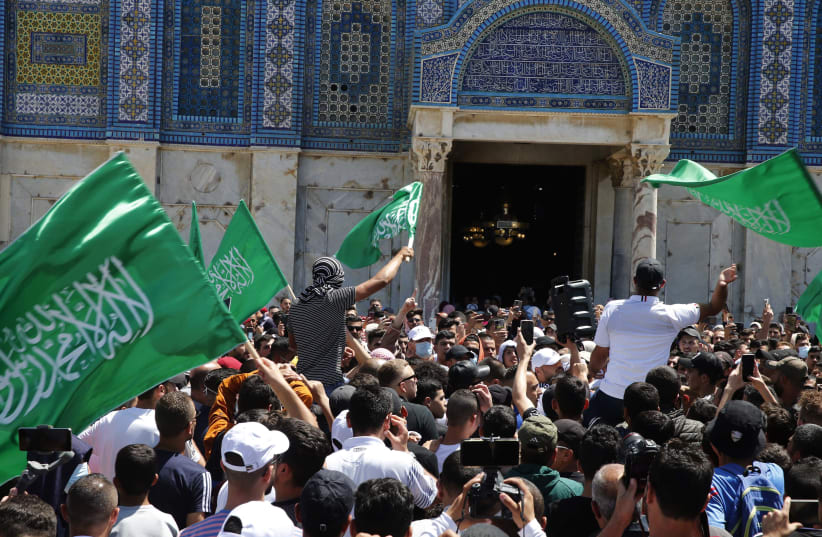Naturally, international attention will focus on Hamas, the Israeli government and reaching agreed guidelines for renewed stability. Although this is necessary, it will only address the superficial part of what caused the fighting to erupt.
Unlike previous rounds of violence (namely the wars in 2009, 2014 and the more limited round in 2012), the causes for the unraveling of the stability are not directly linked to Hamas and its complicated state of affairs with Israel. Since it is east Jerusalem and not Gaza where the deterioration began, we must not forget about east Jerusalem as Gaza urgently calls for our attention.
Hamas has decided – for reasons having more to do with internal Palestinian politics than its hostility toward Israel – to take advantage of the unrest simmering over the last month in east Jerusalem as a means to portray itself as the leader of what had been evolving until then as an east Jerusalem popular struggle on very specific issues. Israel, for its own reasons, also wants to depict Ramadan’s events at Damascus Gate, Sheikh Jarrah and the Temple Mount/al-Aqsa as instigated by Hamas in an attempt to delegitimize the Palestinian popular struggle and camouflage the aggressive Israeli measures throughout the month of Ramadan that caused the destabilization.
It is not the first time that Hamas and Netanyahu’s interests coincide in such a way. We would be wrong to buy into their presentation of things and forget the significantly important campaign that east Jerusalem residents have been waging with much success over the last month.
One of Israel’s major long-term goals in Jerusalem is transforming the Old City Basin from what it is today – a dense Palestinian urban area, which is also the place of some of the most holy sites to the three Abrahamic religions – to one where Jewish nationalistic and religious identity is dominant above all. For this purpose, the Israeli government – aided by settler organizations – is evicting Palestinian families in neighborhoods such as Silwan and Sheikh Jarrah, and just this month the Supreme Court was likely to authorize the eviction of yet another six Palestinian families in Sheikh Jarrah. This is also why the Israeli police aggressively disrupted the Ramadan nights outside Damascus Gate and, most significantly, this is why Israel is consistently working to erode the status quo on the Temple Mount/Haram al-Sharif. The Israeli strong hand in the holy place toward the peak of Ramadan and Jerusalem Day resulted in some of the worse confrontations there, with hundreds of wounded and armed soldiers desecrating the holy place.
Just a few years ago, US president Barack Obama’s administration worked hard to curb those Israeli ambitions and prevent Israel from executing such actions. Since 2009, Israel has not been able to advance evictions in Sheikh Jarrah and had to freeze other settlement initiatives there. Former US secretary of state John Kerry put much effort into receiving an explicit declaration of Netanyahu’s commitment to the status quo on the Temple Mount/Haram al-Sharif and ensure coordination between the Israeli police and Jordanian Wakf in the holy compound. This achieved much calm after the violent events of 2014 and 2015 around the Temple Mount/Haram al-Sharif.
But during US president Donald Trump’s administration, all that has changed. Along with Trump’s breakaway from international law supporting Israeli sovereignty in east Jerusalem and moving of the American embassy to Jerusalem, Israel resumed evictions in Sheikh Jarrah and worked consistently to undermine the Wakf and allow forms of Jewish prayer on the Temple Mount/Haram al-Sharif in violation of the status quo.
For a month, east Jerusalemites have been rallying in a most impressive grassroots struggle to protect their homes, national identity and religious places. With the power imbalance between Israel and Palestinians as it is, no one could have guessed that Israel would be the one having to step back: removing blocks from the most important “city square” next to Damascus Gate, rerouting the nationalistic Jerusalem Day parade away from the Muslim Quarter and postponing the Supreme Court hearing on the families’ evictions in Sheikh Jarrah.
All these achievements were reached by a grassroots struggle portrayed by Israel as being carried out by terrorists, but which for a large part was nonviolent and certainly not armed. East Jerusalemites, by raising their voices, gathering in Jerusalem’s streets and willing to suffer blows by Israeli security forces. have managed to draw wide support to their cause and put the Israeli government under much pressure.
Yesterday, as popular struggle has been taken over by missiles and bombs, the White House in its call to stop the fighting has also finally addressed the negative impact of home evictions in east Jerusalem. So far, the White House’s voice on events in Jerusalem has been painfully missing. This first public statement cannot be considered enough as it limits itself to expressing concern with evictions and does not at all refer to the Temple Mount/Haram al-Sharif and the Old City.
Regardless of the current achievements of the east Jerusalem struggle, it is doubtful whether by themselves they can stop Israel’s policy of dispossession in east Jerusalem. But they have created the perfect setting for the American administration to redraw the red lines that were there until 2017. East Jerusalemites have made it perfectly clear what damage Israeli actions with regards to home evictions, the Aqsa compound and Jerusalem are creating. Past experience tells us that without a clear American stance on these issues east Jerusalemites’ enormous sacrifice runs the risk to have been carried out in vain.
The writer is a researcher at Ir Amim and a fellow at the Forum for Regional Thinking.
